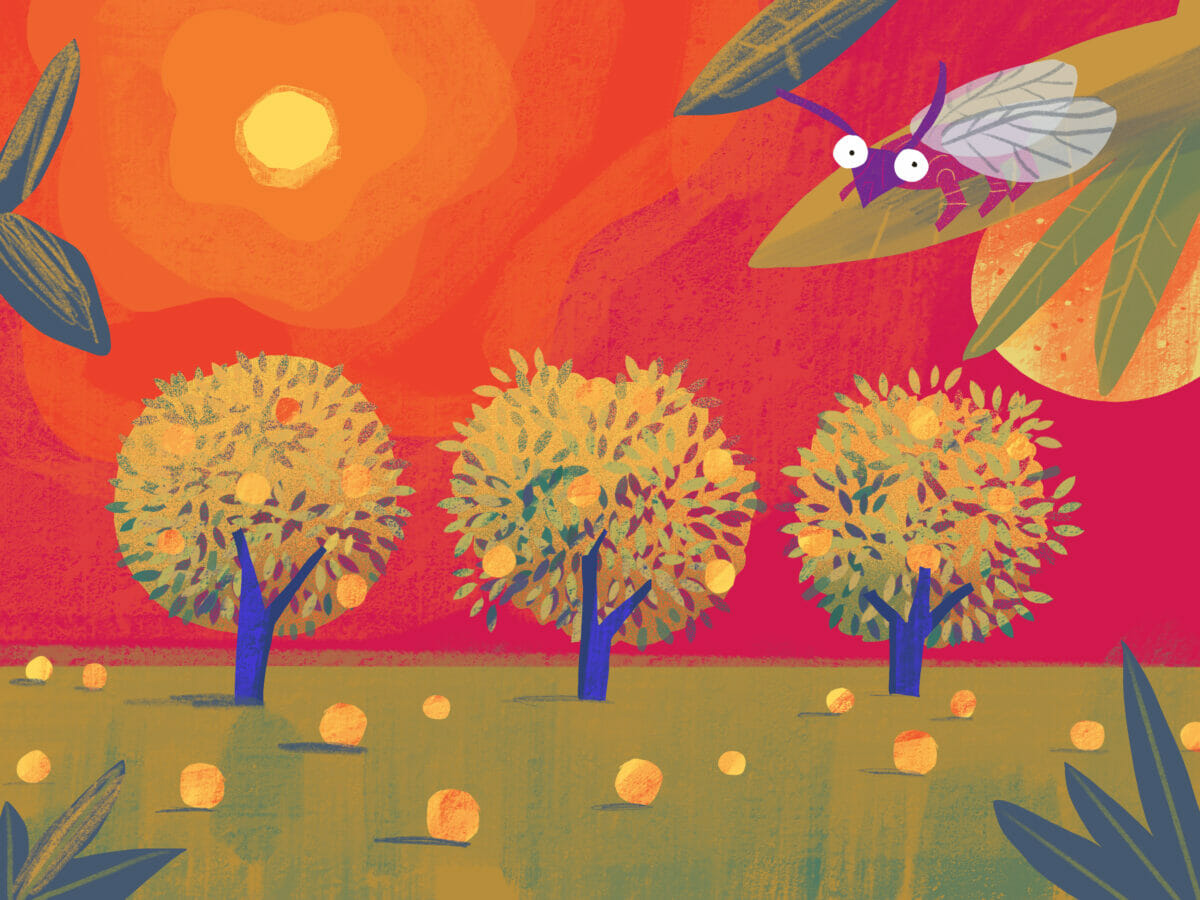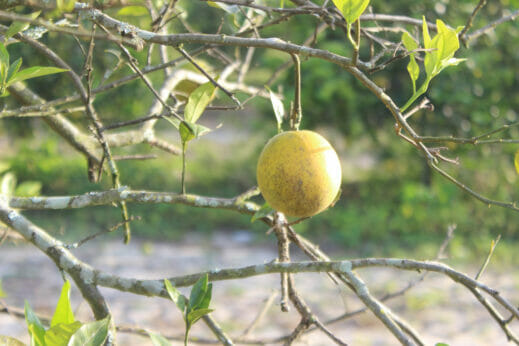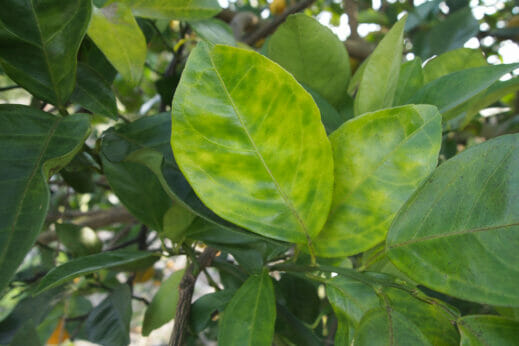The bacteria is fatal to citrus trees and has decimated citrus groves in Florida and Texas. Now, California growers are holding the line to keep producing the vital crops. As temperatures rise, that gets more difficult.

It starts out as unnoticeable, lying dormant for two or even four years. It’s undetectable. But slowly, the signs come out. Individual branches on a tree point to signs of a nutrient deficiency or perhaps overwatering. Branches will start to yellow and weaken, turning shriveled. Then, the fruit will turn, becoming small and refusing to ripen and, sometimes, dropping early. The fruit is safe for human consumption, but it tastes like battery acid.
And once the tree reaches that point, there’s no coming back. The tree will die within a few years no matter what intervention you try. That’s why when growers see trees infected with Huanglongbing, known as HLB or citrus greening, they immediately look to remove the tree. There’s no other option.
“We’re destroying all the trees that get infected. We’re monitoring and eradicating those where we can. We’re using biological controls with the loss. We’re using every tool in the bag,” says Jared Plumlee, senior vice president of farming at Booth Ranches, in Orange Cove, CA. Plumblee oversees about 7,000 acres in the central San Joaquin Valley, growing navel oranges, valencias, mandarins and even some lemons and grapefruits. There’s no sign of HLB in the Booth orchards yet, and Plumlee aims to keep it that way. The ranch also has its own packing house onsite, where they pack only their own product. That’s both to foster trust with consumers, so they know every piece of fruit in a Booth box came from that farm, and to keep potentially infected fruit out.
HLB is a disease spread by the insect Asian citrus psyllid, which infects trees with a slow-growing bacteria while it feeds on their shoots. It’s commonly spread as the insect travels across borders in fruit or tree cuttings, but a warming climate is speeding things along. The transmission of citrus greening depends on temperature—both to ensure that the psyllid survives and that the host trees are at their most vulnerable. Temperatures between 60 and 90 degrees Fahrenheit allow the disease to thrive. Research has shown that areas that stay within that range for at least half of the year have the most cases of HLB.
As global temperatures rise, citrus greening infestations can—and will—move further north. Tracking the spread of HLB is, in some ways, tracking the warming climate.
Growers can often, unknowingly, graft an infected tree limb onto their otherwise healthy stock. That’s how citrus groves in Texas, and most especially Florida, fell victim to the disease. HLB was first discovered in Florida in 2005, where it promptly tore through the state’s orange and grapefruit groves, infecting close to 90 percent of the citrus. Nearly 20 years later, last season’s orange production is a mere 16 percent of the yield in 2003. And overall citrus production continues to fall, every year for the past five years. This year’s orange yield is predicted to be 25 percent lower than last years’ final production.

A Florida citrus tree afflicted with HLB. (Photo: Citrus Pest and Disease Prevention Program)
Across the country, California growers have paid close attention to what their colleagues in Florida experienced, and they have no desire to go down the same road. “We see those numbers [from Florida], and it’s very, very frightening,” says Plumlee. As California’s annual temperatures fall squarely in the range for optimal HLB transmission, growers are as proactive as possible, even getting state legislation passed that allows citrus growers to essentially tax themselves and put the money towards research and eradication programs. “We’ve been fairly successful thus far; it still hasn’t been found in commercial orchards,” says Plumlee.
California is home to roughly 300,000 acres of citrus production across the state. There have been infected trees found in California, throughout Los Angeles and Orange counties and along the coast near San Diego. But, so far, the bacteria has stuck to residential trees or others easily removed.
“Last year, some nursery stock was sent from South Carolina from a nursery that had citrus canker,” says Victoria Hornbaker, director of the Citrus Pest and Disease Prevention Division at the California Department of Food and Agriculture. “But our team was able to react incredibly quickly to get out to those locations, collect that nursery stock, destroy it and do a one-mile survey of all citrus around those locations to make sure that we didn’t see any symptoms of citrus canker in the environment. So, that is a good example of how quickly we can mobilize and respond to potential issues regarding citrus.”
The citrus industry isn’t just important within California, but across the country. Florida may be known for oranges, but it’s primarily grown oranges for juice. California has historically been the home of fresh citrus, growing 85 percent of the nation’s table fruit. “If we lose California citrus, we also lose our national and international market,” Hornbaker says. That means importing more citrus from outside the country, raising prices, and losing a tremendous amount of revenue all around.
That’s why California growers have such a focus on proactivity, and why there’s an incredible amount of research into citrus greening coming out of California institutions. University of California, Riverside is working on a treatment that effectively kills the bacteria, although it’s still being tested within industry. Growers are experimenting with higher-density planting, putting more trees in the ground per acre, to get a higher yield in a shorter amount of time. Although, as Plumlee explains, that also has a significant drawback. “The longevity of planting like that might not be 50 years; it may only be 25. Because once the trees fill in, you kind of hit this plateau on what your production level can be. So, in the face of HLB, you’re going to turn the ground over faster.”

Yellowing leaves are an early sign of HLB infection. (Photo: Citrus Pest and Disease Prevention Program)
Breeders are also working to find new varieties that are less susceptible to HLB. The Sugar Belle mandarin, the hybrid of a clementine and a Minneola, has shown promising resistance. The new variety was born out of research from the University of Florida and released to growers across the state in 2009. More than a decade later, the Sugar Belle is among the top-grown varieties in the state.
Oddly, there does seem to be a correlation between the size of the citrus and the resistance to the bacteria, although it’s not clear if size is a determining factor or simply a coincidence. But Neil McRoberts, a professor of plant pathology at University of California, Davis, says that grapefruit and large oranges are less resistant to the disease, with smaller mandarins showing more disease resistance. “Because our citrus comes from so few different progenitor lines, they don’t have any natural resistance to the bacterium. So, none of our favorite citrus types and varieties have much resistance in general,” McRoberts explains.
There could be a cure out there. But it won’t be on the horizon in five years or even 10. “I can see that, maybe in 20 years, we’ll be in a position where, if we don’t actually have a cure, we’ll at least have citrus that is able to stand up and keep producing a crop,” says McRoberts. “There are some promises out there, but it’s slow work.”
In the meantime, Plumlee and other growers have no choice but to keep going and keep growing. “You can’t just throw up your hands and quit. You keep doing the science and the trials and try to solve this puzzle. But, in the short term, there’s not a whole lot that you can do that we haven’t already done.” Growers like Plumlee have a crop that’s vital to the state and the nation and a disease that they are fighting to keep at bay. For now, they simply have to hold on—for a decade or two—until more effective methods are available.
“That is the scary part,” says Plumlee. “If we had something today, right out of the lab that works, we’re still 10 or 15 years from proving it out that it actually works. And then another 10, probably before it’s all implemented out in the industry. So, we know that time is not our friend.”
This story is part of State of Abundance, a five-part series about California agriculture and climate change. See the full series here.

Shocking that this story is so completely wrong and scientifically incorrect in many areas. A simple Google search of Greening cures in Florida, if the author had done so, would have helped fact check a few things. The most laughable falsehood here is that Florida’s disease spread came from cutting and diseased grafting. Anyone with a fleeting knowledge of the situation knows that’s not close to true. The disease was spread by the psyllid and the State’s lack of commitment to try and stop the psyllid, which unfortunately is an extremely efficient vector for HLB. There is a cure. It… Read more »
What’s the original, evolutionary habitat of citrus, oranges, lemons? We would have to look at where they’re native and have evolved for millions of years, within the forests of Asia, probably China. It’s not an emergent tree in that forest, it’s not even a high canopy tree. You could classify it as a mid-canopy tree. Those forests have many deciduous trees above the citrus that lose their leaves at a certain time of year every season. Could we replicate to some degree the natural environment that citrus has been adapted to over millions of years in our plantations? It has… Read more »